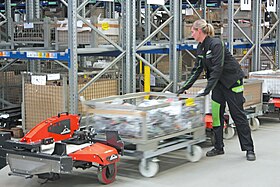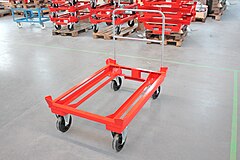Tugger train
Tugger trains , also known as logistics trains , are means of transport for internal horizontal material transport in plannable, standardized intralogistics processes. Tugger trains are forklift trucks that primarily supply production / assembly with production equipment from the warehouse, also known as “supermarkets”, just-in-time. They can transport several load carriers per trip and, compared to other industrial trucks, achieve enormous increases in productivity in horizontal material transport while at the same time minimizing the volume of internal traffic. That is why tugger trains are the most economical and safest solution for internal horizontal material flows.
Areas of application
Tugger trains can cover very different tasks and areas of application. Wherever material has to be transported horizontally over a long distance from A (source) to B (sink), tugger trains are an economical and safe solution. Tugger trains are primarily used in the processing industry, where the means of production have to be transported from the warehouse to the production and assembly sites. But many other areas of application can also be covered with tugger trains. So z. B. for internal waste disposal, in leisure parks, at airports, at train stations, in the pharmaceutical industry, in authorities or in the food industry and gastronomy.
functionality
The transported goods are usually picked up by the tugger train at the source (warehouse, also called “supermarket”) using load carriers (e.g. trolleys). The load carrier with the goods being transported is driven to the sink by the tugger train (unloading point, e.g. production line). At the same time, empties can be picked up again with the tugger train. Due to several goods carriers and thus several parking spaces per tugger train, more can be transported and several depressions can be approached within one tour / trip. Compared to forklifts, the tugger train saves you unnecessary trips to the warehouse and reduces internal traffic. The loading / unloading process and driving can be done manually by the driver / operator or automated, depending on the type and characteristics of the tugger train.
construction
A tugger train consists of a towing vehicle and several trailers, also called goods carriers. The transported goods are loaded onto the goods carriers via load carriers. As a rule, the goods carriers are lifted out (e.g. using an electric hoist) so that the load carriers do not “ride along” or “roll” during transport.
Towing vehicle
Electric tugs are used as towing vehicles, which are converted accordingly for the use of tugger trains. The type of tractor is selected according to the trailer load and location (indoor and / or outdoor).
Product carrier
Various systems are available as goods carriers, i.e. for holding the load carriers with the transported goods. The systems differ in terms of loading direction and type. Systems that can be loaded on one side and on both sides are available as loading directions. Floor-level and non-floor-level systems are available as loading methods. Floor level means that the load carrier can be pushed in at floor level, the load carrier does not have to be pushed onto the goods carrier via a ramp or the like. Not level with the floor means that the load carrier has to be pushed / rolled onto the goods carrier (e.g. over a small ramp). For systems that are not level with the floor, a maximum weight of the load carrier of 350 kg is recommended.
- Examples of goods carrier systems
- C-frame (one-sided, flush with the floor)
- E-frame (one-sided, flush with the floor) with up to 6 adjustable or permanently welded forks
- Platform frame (on both sides, not at floor level)
- QS (Quick Save) frame (on both sides, not flush with the floor)
- Bracket frame (on both sides, flush with the floor) with up to 3 adjustable or fixed vertical struts
charge carrier
The load carriers are very individual and differ from use to use. Often the goods to be transported are loaded on sliding pallet chassis / trolleys onto the goods carriers or onto the tugger train. If load carriers are already available in the company, the goods carriers are specially adapted to the load carrier specifications.
- Possible load carriers (trolleys) for loading the tugger train.
Automated tugger train
Tugger trains can also be operated automatically. Either individual processes or functions can be automated, or the entire tugger train process can be automated.
Automated driving
The towing vehicle (tractor) is automated for the automated driving of a tugger train. Various options are available for this, which enable the tugger train to be navigated independently.
- Driving or navigating can be done in the following ways
- Geonavigation
- Magnetic tape
- Magnetic points / RFID
- Optical (e.g. color ribbons)
Mixed navigation, i.e. hybrid navigation, is also possible. Ie different types of navigation are combined in one application.
Partially automated driving
Semi-automated driving is also possible, for example for precise positioning in automated charging processes. The tugger train positions itself automatically and automatically for loading / unloading. The tugger train is partially automated: that is, the tugger train is driven manually by a driver until shortly before the transfer station. When approaching the transfer position, the driver then activates the automation in 2-hand control. The steering is thus completely automated and the tugger train drives independently at a specified speed to the exact transfer position at the sink / source. The driver can stay on the tugger train during the loading process and monitors the process until it is fully completed. After the automated loading process has been completed, the driver takes over the tugger train again and can head for the next station.
Personal protection system in automated tugger trains
In order to have tugger trains run automatically, personal safety must be guaranteed. The entire tugger train must be permanently and fully monitored with personal protection systems (PSA). From the tractor to the last trailer, the tugger train is covered with a “protective field”, so to speak. Several safety scanners secure the tugger train, both the direction of travel and the lateral areas are permanently monitored. The safety scanners are integrated in the tractor and in each individual product carrier. The safety scanners scan the environment and generate a warning and protective field around the tugger train. If a person enters the area around the tugger train, the warning field is activated and the tugger train reduces its speed. If the person then reaches the protective field, the tugger train stops immediately.
Automated driving in the outdoor area
In order to have tugger trains run automatically in the outdoor area, special safety laser scanners are required that are specially designed for outdoor use and also work safely in weather conditions such as sun, rain, snow and fog and thus for a stable and, above all, safe and reliable Process.
Automated loading / unloading
For the automated charging process, the load transfer from the source to the tugger train or from the tugger train to the sink is automated. How the automated load transfer takes place depends on the local conditions and existing processes at the customer.
- The following basic options are available
- Load transfer from / to driven roller conveyors
- Load transfer from / to non-powered roller conveyors
- Load transfer with extendable telescopic forks from load carriers / pallets standing on the floor
- Load transfer via automated underride AGVs (driverless transport systems)
advantages
When it comes to horizontal material transport, tugger trains have considerable advantages over other industrial trucks, which can be broken down into economic, ecological and safety-related advantages. Tugger trains can pick up a lot of material and transport it over long distances in a very short time and approach several depressions within one tour. Compared to forklifts, tugger trains can achieve up to 3 times higher productivity. Fewer vehicles and fewer personnel are required. The ROI for tugger trains is achieved in a very short time. Fewer vehicles also mean less environmental pollution. In addition, tugger trains are operated electrically and therefore do not cause any exhaust emissions. Fewer vehicles also means less internal traffic and thus a reduction in dangerous situations and accidents. The safety for people and material increases through the use of tugger trains for internal horizontal material transport.
Web links
- Video: Schnellecke Logistics supplies BMW Dingolfing with Factory Train tugger trains
- Video: Factory Train tugger trains supply the assembly line at Same Deutz-Fahr in Lauingen
- Video: Dethleffs caravan assembly with Factory Train tugger trains from Neumaier
- Video: Alpine intralogistics in Sölden with the Factory Train tugger train

















